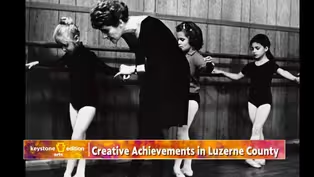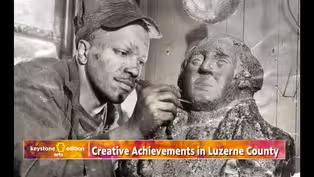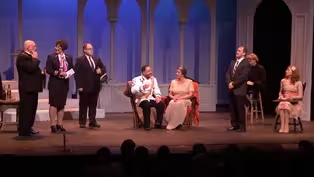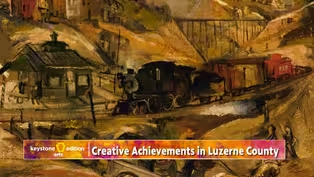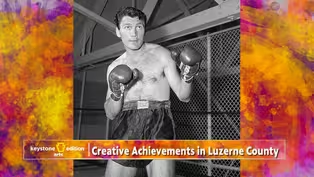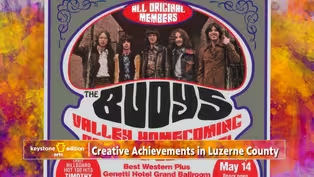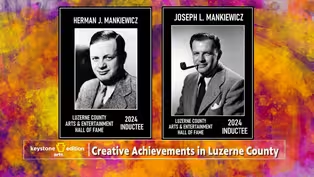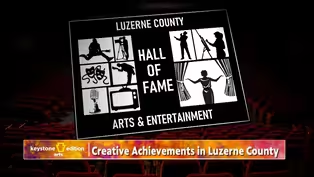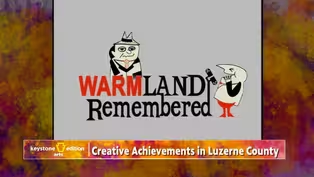Keystone Edition
George Catlin
Clip: 11/25/2024 | 1m 59sVideo has Closed Captions
Wilkes-Barre historian Tony Brooks reflects on the legacy of George Catlin
George Catlin, born in Wilkes-Barre in 1796, preserved Native American history through his iconic art, including portraits and scenes of tribal life. His works, such as the buffalo bull, have been displayed in the Louvre and the White House. Annette Evans, founder of the Fine Arts Fiesta, honored Catlin's legacy by showcasing his art locally, celebrating his profound impact on American culture.
Problems playing video? | Closed Captioning Feedback
Problems playing video? | Closed Captioning Feedback
Keystone Edition is a local public television program presented by WVIA
Keystone Edition
George Catlin
Clip: 11/25/2024 | 1m 59sVideo has Closed Captions
George Catlin, born in Wilkes-Barre in 1796, preserved Native American history through his iconic art, including portraits and scenes of tribal life. His works, such as the buffalo bull, have been displayed in the Louvre and the White House. Annette Evans, founder of the Fine Arts Fiesta, honored Catlin's legacy by showcasing his art locally, celebrating his profound impact on American culture.
Problems playing video? | Closed Captioning Feedback
How to Watch Keystone Edition
Keystone Edition is available to stream on pbs.org and the free PBS App, available on iPhone, Apple TV, Android TV, Android smartphones, Amazon Fire TV, Amazon Fire Tablet, Roku, Samsung Smart TV, and Vizio.
Providing Support for PBS.org
Learn Moreabout PBS online sponsorshipAnd, of course, George Catlin, you think about it, is our most famous export, more so than anthracite coal, 'cause George Catlin, you can still go see today, you can go to the Smithsonian, but think about this.
George Catlin was born where the Dunkin' Donuts is on Public Square back in 1796, went off to the Pennsylvania Academy of the Fine Arts, and decided to, well, if you think what a little boy, he's hearing about Lewis and Clark and all these wonderful exhibitions and traveling of the Native Americans on the Great Plains of the Missouri and Mississippi Rivers, and he wants to go see it for himself.
And thank God he did, because George Caitlin did it in such a way and at such a time right before a lot of these Indian tribes get wiped out by either our diseases or the bullets of our guns.
And thank God he did what he did, because he preserved for eternity all the history of these particular tribes on the Great Plains.
- And often he did portraits, didn't he, of some of the leaders of the tribes?
And there's such dignity and respect in his work.
- Correct, so he did chiefs, their wives, religious festivals, hunting buffalo.
He is the person who made the American buffalo an icon of American history.
You think about it.
We put the buffalo on our nickel.
We have it for so many different years.
But the most fascinating thing is, and I can see George Catlin's buffalo bull up on the screen, that that painting was in the Louvre in Paris and in the Oval Office at the White House.
Now, what other person from Wilkes-Barre could do that?
(chuckles) - George Catlin's the one.
- Right.
- And do we know that Annette Evans had an interest in George Catlin and wrote about him and brought some of his paintings back?
- Correct, she did an exhibition of George Catlin here, and she was a big fan of his.
And thank God we have Annette Evans too and all the work that she has done since, well, 1956, when she started the Fine Arts Fiesta.
Just wonderful.
- Wow, Tony, thank you.
Video has Closed Captions
Clip: 11/25/2024 | 2m 57s | Weisiberger, founder of the Pennsylvania Ballet, played a vital role in promoting ballet in America. (2m 57s)
Video has Closed Captions
Clip: 11/25/2024 | 2m 31s | His daughter highlights his innovative approach and deep connection to coal in the region (2m 31s)
Creative Achievements in Luzerne County - Preview
Preview: 11/25/2024 | 30s | Watch Monday, November 25th at 7pm on WVIA TV (30s)
Video has Closed Captions
Clip: 11/25/2024 | 2m 55s | Dr. Darlene Miller-Lanning, director of the Hope Horn Gallery, speaks about Franz Kline. (2m 55s)
Video has Closed Captions
Clip: 11/25/2024 | 43s | Jack Palance, born to a coal-mining family, transitioned from miner to boxer to acclaimed actor. (43s)
Max Furek / Luzerne County Music
Video has Closed Captions
Clip: 11/25/2024 | 4m 6s | Max Furek, journalist and author, discusses his passion for Northeastern Pennsylvania's music scene. (4m 6s)
Video has Closed Captions
Clip: 11/25/2024 | 1m 35s | Herman Mankiewicz’s childhood in Wilkes-Barre inspired the iconic "Rosebud" in Citizen Kane. (1m 35s)
Clip: 11/25/2024 | 1m 47s | The Fine Arts Fiesta celebrates diverse art forms, from exhibits to performances. (1m 47s)
Video has Closed Captions
Clip: 11/25/2024 | 3m 5s | Recollections of the vibrant atmosphere at WARM radio. (3m 5s)
Providing Support for PBS.org
Learn Moreabout PBS online sponsorship
- News and Public Affairs

Top journalists deliver compelling original analysis of the hour's headlines.

- News and Public Affairs

FRONTLINE is investigative journalism that questions, explains and changes our world.












Support for PBS provided by:
Keystone Edition is a local public television program presented by WVIA
